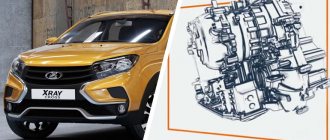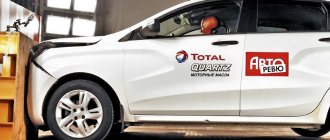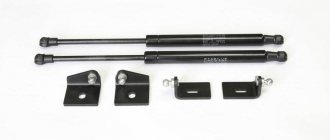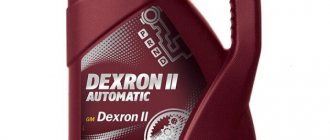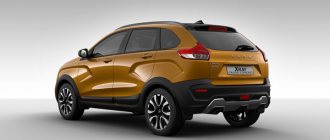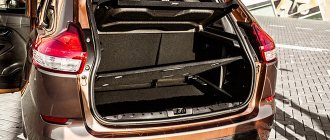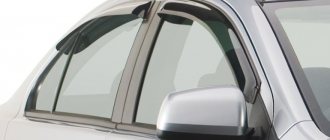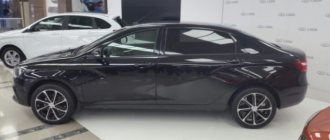The main differences between VESTA and X RAY
Briefly about each model. Lada Vesta is a sedan, developed from scratch, so a lot of time was spent on design. The model was expected by AvtoVAZ fans, and therefore quickly became popular.
Lada X-Ray is still more of a hatchback body than a crossover, but the issue is debatable. The platform for further development of the model was the Renault Sandero car, so the design took relatively little time. A reliable foundation that has been tested by time has become the strength of XRAY.
Why isn't X-ray a crossover? The lack of all-wheel drive could indicate that the Lada is actually a hatchback, but at the same time, the main difference between the CUV body is the corresponding appearance and high seating position, and all-wheel drive is not always available. What does this mean? That XRAY has both sides, and you have the right to consider it both, because... the question of its body is controversial.
Test results
Expert assessments were given based on a number of criteria.
Ergonomics
. Vesta provides good planting geometry. XRAY is worse, despite adjusting the steering wheel for reach and a new seat. Niva is about the same level, but unless you are above average height (the range of seat adjustments is limited). But visibility is better (huge mirrors, powerful headlights). Vesta is let down by wide pillars, and XRAY is let down by small mirrors.
Dynamics
. Vesta accelerates and turns more pleasantly than anyone else. The Niva is slow, but its connection to the gas pedal is much clearer than that of the more dynamic XRAY, which is uncomfortable to drive. Equal scores with the Niva for handling are associated only with the lack of a stabilization system on the Niva - the chassis itself is better tuned. In terms of cross-country ability, there is no equal to the Niva.
Ride comfort
. Despite the additional sound insulation of the Cross version, XRAY turned out to be noisier than Vesta due to the disgusting sound of the engine. Niva in the “civilian” version without a snorkel does not frighten with unnecessary noise at all permitted speeds and is noticeably superior to Crosses in terms of smoothness.
Comfort in the cabin
. Vesta is longer than the others and, as expected, wins over everyone in terms of rear space and trunk volume. And the compartment is well thought out. The Xray and Niva are all more modest, and the Chevrolet transformation is from the last century: to recline the backs of the rear seats, you first need to raise the pillows.
As a result, the total score was calculated, which determined the winner:
After the Lada Vesta model appeared on the horizon, many of those who intended to purchase a car opted for a new domestic sedan. However, this situation persisted only until the Lada X-Ray hatchback began to roll off the assembly line. This is where many potential buyers became confused, not knowing which model to give preference to. Should you buy a Vesta, tempted by the low cost and the familiar sedan body, or pay more and get a practical and powerful hatchback in return? This dilemma should not remain unanswered!
Lada X-Ray or Lada Vesta? The question is clearly not an easy one.
Model specifications
Lada Vesta can be filled with 92-octane gasoline, but its brother is advised to use 95-gasoline, which is more expensive, considering the price of fuel. Both the sedan and the hatchback have front-wheel drive, the same speed - 4200 rpm. and acquired many auxiliary systems: ABS, ESP, etc.
The difference between Vesta is that it has an enlarged tank - 55 liters, the body has one less door than the hatchback - 4 (X Ray has 5), its average consumption is less, only 6.9 liters, but, unfortunately, only 2 airbags.
The Lada X-Ray has a smaller tank - 50 liters, a higher consumption - 7.2 liters, but it has 4 airbags, including side airbags, which Vesta does not have.
Let's look at the main distinguishing characteristics in more detail below.
You can leave reviews about the Lada Vesta sw Cross here
Ride and Handling
The Vesta Cross sedan has the same chassis as the previous SW Cross station wagon and, apart from the body type, there are no significant differences. Their main units are identical, even many body parts are compatible. There is a difference in the suspension design (springs, shock absorbers), and in the bifurcated muffler and plastic body kit, which cannot be installed on a regular Vesta sedan.
The difference in price between just a Lada Vesta and Vesta with the Cross prefix, depending on the version, is 53 – 63 thousand rubles. If you choose between a “cross” sedan and a station wagon, then the cost of the latter will be 32 thousand more expensive - this is a standard surcharge for the two-volume body of the Vesta.
Transmission Lada Vesta and X-Ray
Neither Vesta Cross nor XRAY differ from each other in their set of engines and gearboxes. But the hatchback has more trim levels and the price for the initial version is 579,900 rubles versus 763,900 for Vesta. However, the sedan has better handling and acceleration dynamics. But there are controversial points : Vesta Cross drives normally on the highway, but in traffic jams there is a noticeable lack of traction at the “lower levels”.
The top version of XRAY has a trump card hidden up its sleeve - “robot”! It is he who helps where it is difficult to travel. However, sometimes it is inadequate in choosing driving modes, so most owners prefer “mechanics”: nerves are more expensive.
The transmission of the Vesta Cross sedan is slightly different from that found on station wagons. According to the manufacturer, the robotic gearbox of the top-end Vesta now changes gears faster. True, journalists who could tell about the updated “robot” AMT 2.0 never got it. In this regard, you’ll have to take the marketers’ word for it... But no one has any complaints about the “mechanics”. probably a draw in this round between Cross and XRAY.
Available engines and fuel consumption
For both cars, engines with a displacement of 1.6 and 1.8 liters, with a power of 106 and 122 hp, of domestic production are available. It is worth mentioning separately the Japanese motor for the XRAY, which is currently no longer installed on it , since it is more expensive and more difficult to maintain. As for the VAZ 1.8-liter engine under the symbol VAZ-21179, it is, in fact, experimental and there are complaints about it. There is an opinion that its 122 “horses” are not enough for country roads, so overtaking must be done with careful calculation, as if you were a racer. The tachometer cutoff occurs earlier than expected.
However, within the city the dynamics of the 1.8-liter unit are sufficient. But real fuel consumption is controversial: it never drops below 8 liters per “hundred” . But here Vesta and XRAY maintain parity: the engines are the same! Moreover, Vesta is definitely capable of driving 700 km on a full tank without refueling, but under conditions: on good roads and with high-quality gasoline. Speaking of fuel, there are differences: Vesta needs 92 gasoline, while XRAY uses AI-95. Taking into account current fuel prices, this can play a decisive role in the choice between the cars under review. But there is a mitigating point here - after upgrading the VAZ-21129 engine, the use of AI-92 is also allowed.
There is no point in even comparing them in terms of speed: both cars are designed for relatively quiet driving. These are not sports sedans, but rather cars for travelers (with a stretch) and for family people (the latter applies more to the XRAY).
Suspension and handling
The Vesta Cross sedan's ride turned out to be worse than that of conventional sedans - the stiffer suspension and 17-inch wheels with low-profile tires (205/50 R17) are to blame.
But the car turns confidently and without rolls. And no road bumps can throw Vesta off course (which cannot be said about the oncoming air currents from oncoming trucks on country highways).
In terms of handling, Vesta is more playful than Xray, which especially helps on unpaved sections of the road and off-road. The steering wheel responds to even the slightest movement.
Wear tests
According to life tests of the Autoreview magazine, in 2016 the Lada XRAY hatchback traveled 32 thousand kilometers and passed tests in a corrosion chamber. In the summer of 2022, the Lada Vesta Cross passed the endurance test of the Fifth Wheel magazine, covering 9.5 thousand kilometers. What were the results?
XRAY showed unsatisfactory performance of doorways: dirt seeped in everywhere. At the same time, resistance to corrosion was exactly at the level of competitors on the B0 platform under the Renault brand. As far as we know now, the seals have been redesigned and they no longer cause problems.
It became easier off-road with switchable ESP. This was noted by all reviewers who dealt with the Xray crossover. During the tests, shortcomings in the factory firmware of the engine ECU were revealed, which have now also been eliminated. The robotic gearbox has shown its reliability.
However, in terms of the cost of scheduled maintenance, we get a VAZ at Renault prices. The overall reliability rating of XRAY showed only 14th place out of 19 according to Autoreview for 2016. Even taking into account the rising prices for spare parts, any previous Lada is cheaper in this regard than Xray.
Difference in dimensions between VESTA and X RAY
The width of the models is identical, 1.764 m, but the length is different, Vesta is lower - 1.497 m, than X-ray - 1.57 m, but longer - 4.41 m and 4.165 m for the second model. The sedan's wheelbase is 2,635 m, while the hatchback's is 2,592 m.
In terms of ground clearance, the X Ray wins, it has 19.5 cm, while Vesta has an acceptable figure of 17.8 cm. The trunks differ greatly in volume, Vesta was given 480 liters. capacity, and XRAY is only 361 liters. But you need to take into account the advantageously lower weight of X-ray, which is 1190 kg, when Vesta weighs 1 ton 230 kg.
From all the mentioned indicators, we can conclude that Vesta, due to its greater length and, accordingly, wheelbase, is more comfortable, but the X-ray has increased ground clearance, and therefore greater cross-country ability. And also Vesta with a large trunk is more spacious and convenient for transportation, and the X-ray, in turn, looks larger, although in fact it is lighter, which is also a plus.
Lada Vesta Cross or X Ray: comparison of cars
First, let's evaluate the sales level of these models. Since Vesta in the “Cross” version was launched on sale quite recently, we will take sales of regular Vesta sedans and station wagons and compare them with the X-Ray indicators. There is the following data:
- a year after the start of production, the number of Lada Vesta station wagon cars sold reached 8,000;
- Lada is ahead of its competitors in terms of total sales of passenger cars;
- from January to August 2022, Vesta was the second most popular car after the Kia Rio, while the X-ray was only in 9th place. These are the total figures for the Vesta model, including the sedan and station wagon.
The statistics are already giving us pause. On the other hand, these data reflect not so much the quality of the cars sold, but the preferences of the car enthusiasts themselves and their purchasing power.
The average price for Vesta in the Cross version is about 788,900 rubles, while XRay will cost almost 100 thousand cheaper.
And if everything is clear with popularity, then from a price point of view the advantage is clearly not in favor of the Lada Vesta.
Appearance
The same design idea, similar lines on the body. This decision of designers and engineers is due to the high popularity of Vesta, which is why they wanted to do something similar for 100 percent success. The front parts of the cars are almost the same, similar, including the hood and side parts with “X” patterns, which give the Lada a more modern look.
The sedan is more dynamic, good for young people, it also has better noise and anti-corrosion protection. The Lada X-ray looks solid in appearance, suitable for wealthy people, the front part is slightly shortened. One of the main drawbacks for car enthusiasts is small-diameter wheels, or rather large wheel arches, against which the wheels seem smaller than they actually are. The model should be modified with improved noise protection and wider wheels.
Body and dimensions
Externally, Lada Vesta and X-Ray are so similar that if it were not for the difference in height and body shape, one could confuse them even if they were placed next to each other. They have one thing in common: design at the level of modern foreign cars and the famous “X-DNA”.
Vesta Cross is a sedan, while the X-Ray is a hatchback. Vesta Cross is slightly lower and longer than the X-ray (4424 millimeters in length versus 4165 for the hatchback) and visually this gives it a more rapid appearance.
Dimensions of Lada Vesta Cross
Vesta Cross station wagon (Lada Vesta SW Cross) has the same dimensions as the sedan, with the exception of height - SW Cross has become 11 mm higher.
Dimensions of Lada Vesta SV Cross
Externally, Iksray gives the impression of a more “muscular” comrade - a small “jock” of the domestic automobile industry, taller and shorter than the elegant Vesta Cross.
Dimensions of Lada XRAY
Where the Vesta Cross modification definitely wins externally is in ground clearance (203 millimeters versus 195 for its competitor). It's a small difference, but there are situations in which even a small advantage can be significant. Russian roads in a number of regions prove this truth every day. At the same time, do not forget that a loaded car loses 2-3 cm of ground clearance.
Lada X-Ray stands out from its competitor with a high window sill line, visually making the car somehow more powerful. “Compact high hatchback” is how it is officially called, and the Lada X-Ray fully justifies this name.
After just a couple of years of launching into the series, the Lada Xray has already completely fit into everyday reality, is selling well (see statistics at the beginning of the article) and has found constantly warring armies of fans and haters on the Internet.
The fact is that AvtoVAZ wanted to stuff a newly designed body into the base from Renault Sandero Stepway. The result was controversial.
The dimensions of the VAZ Xray are almost identical to the Sandero, including the length of the body and the size of the wheelbase. Even the head optics are very similar to those installed on the Stepan. But despite its continuity, the new Lada has become a market bestseller, although not as popular as Vesta.
The XRay body turned out to be truly original in appearance, although the Sandero is considered a more status model by the group. Partly because the basic version has only 15-inch wheels, and only higher trim levels can afford 16- or 17-inch ones.
Xray is the result of a compromise integration of a new body into a chassis that has long been mastered on the assembly line. Questions may arise here regarding the passive protection of passengers, since the car has not passed the EuroNCAP tests. But many were most disappointed by how the production hatchback looks compared to the concept.
This is the production car:
And this is the design prototype:
Agree that the car has lost most of its charm. All that remains is the notorious letter X in the front part and on the side stampings. But the result was at least a repairable design. Just ask yourself: could the manufacturing plant change assembly equipment and retrain staff in a short time? That's it...
Characteristics of VESTA and X RAY
The sedan loses in the number of assortment of units; only one engine is installed on it, which is also available for the X-ray. With a volume of 1.6 liters, 106 horsepower, 4 cylinders and 16 valves, the engine is installed on most models of the brand and is time-tested, therefore it is reliable.
Although Vesta is heavier, it reaches 100 km faster, in just 11.3 seconds, while the crossover will reach the same speed in 11.5 seconds at best. The maximum speed is the same for both cars – 175 km/h.
Consumption is also +/- the same, Vesta will use 9.3 liters in the city, 6.9 liters in the combined cycle, and 5.5 liters on the highway, and the X-ray will “eat” 9 in the urban cycle. 3 liters, the average consumption will be 7.2 liters, and outside the city 5.9 liters.
XRAY has 3 unit options to choose from. Two powerful 1.6 liter engines. and 1.8 l. The first engine developed by the Renault-Nissan concern has 110 hp. and a maximum speed of 184 km/h, and the second 122 hp. and the maximum speed is 2 km/h higher than the previous one.
Conclusion
Despite the fact that these two representatives of the Tolyatti concern are assembled on the same platform and have the same units and components in their designs, they are still different. They differ in driving behavior, handling, some little details in equipment and much more. It is impossible to say unequivocally which of them is better, each is good in its own way. The final choice remains with the buyer, who will weigh the pros and cons and choose the best option for himself.
We tried to compare the two most popular domestic cars under the Lada brand: Vesta and XRay. Read on to find out what came of it.
Difference in model transmissions
This similarity may seem strange, but there is practically no difference in the gearboxes. Both models are equipped with a 5-speed manual transmission and a robot. The whole difference is in the production. At Vesta, the mechanics are assembled by AvtoVAZ, and the robot is manufactured in France. Unlike X-ray, the gearboxes of which are always French-assembled.
There are no complaints about the mechanics. The robot sometimes switches gears for a long time, which is why there are jerks. But the gears do not slip out, the transmission is quite quiet and precise. The absence of a classic automatic machine is explained in order to reduce costs.
Handling and off-road performance
Not being a classic city SUV, the Lada XRay Cross turned out to be a fairly maneuverable cross-hatch, and the presence of serious ground clearance allows the owner of this model to overcome not only minor bumps on the road, but also serious obstacles without any problems.
Probably the main drawback of the model, due to which the car cannot be classified as a full-fledged SUV, is the lack of an all-wheel drive system. The presence of 17-inch wheels and high ground clearance give no reason to doubt that a cross-country domestic hatchback can solve many problems associated with poor-quality road surfaces and off-road conditions. And only the lack of an all-wheel drive system can lead to the fact that overcoming difficult conditions will be a serious obstacle for the driver.
Maximum configuration
Vesta in the “Lux” acquired a 16-diameter casting, all the handles and mirrors are in body color, full power accessories, even rear parking sensors, an audio system with 6 speakers, heated windshields and door lighting when it is opened.
For comfort, the cabin now has air conditioning, climate control, rain and light sensors, a glove compartment with a cooling system, an armrest, an eyeglass case and a mirror in the visor.
How will Xray Vesta respond? It has fog lights at maximum speed, a retractable compartment under the passenger seat, a double floor in the trunk, a heated glove compartment and even enhanced tinting of the rear windows.
Prices for new AvtoVAZ products
Prices for Lada Vesta and Lada X Ray are displayed in detail on the official website of Lada cars. The significant difference in price from the basic configuration to its maximum performance is explained by the large number of options and generous equipment of the car. How much this or that modification will cost depends on the buyer’s preferences.
Basic equipment
Lada Vesta with the most modest Classic equipment and a base engine paired with a manual transmission will cost the buyer 545,000 rubles. The list of equipment already includes all the necessary safety systems for skidding and loss of control, two airbags and some pleasant little things for comfortable driving.
The cost of the X Ray in the minimum Optima configuration with the same engine and manual transmission starts from 600 thousand rubles. The equipment of the crossover is distinguished by the presence in the “base” of an installed audio system with speakers and modern functionality. In addition, X Ray is equipped with electric power steering, unlike Vesta’s electric power steering.
Maximum configuration
Prices for the new Vesta in Moscow with a “robot” and a more powerful engine start at 650,000 rubles for the average Comfort equipment. The maximum list of Luxe/Multimedia options will cost 735 thousand.
Differences between cars in the interior Similar equipment of a crossover in the average Luxe configuration will cost 760,000 rubles. The price of the top version Exclusive will be 830 thousand. The crossover has a more generous package, which includes:
- interior lighting;
- presence of an additional socket in the trunk;
- 17" alloy wheels;
- double luggage compartment floor;
- folding rear seats that create a flat surface for carrying additional luggage;
- leather trim of the gearshift knob and steering wheel;
- the presence of an additional box under the front passenger seat;
- original design of seats and interior Exclusive.
Price
Both models are budget, in the basic set Vesta costs 529 thousand rubles, in luxury equipment 672 thousand rubles. If you want to paint your car in the signature lime color, you will have to pay an additional 30 thousand.
For a Lada X-ray in basic equipment you will pay 589 thousand, and in the maximum version 742 thousand. If you want to choose a metallic color, the additional payment will be 10 thousand.
The conclusion is obvious: Vesta is cheaper, given the minimal difference between the trim levels of different models.
Vesta or Khrey, what to choose or what is better, write your opinion in the comments
The second minus is the cramped interior
Ixray also inherited a cramped rear row of seats from the co-platform Renault Stepway. There is not enough air for its inhabitants. Once a person of above average height is behind the wheel, he will no longer be able to sit comfortably. And the trunk, which holds 304 liters (according to ZR measurements), cannot be called gigantic by modern standards.
In a word, if the price does not scare you, and there is no urgent need for a super-spacious trunk, then the Lada XRAY Cross is a completely worthy choice even against the backdrop of numerous competitors.
- Finally, stylish cars have appeared in Russia, and in a decent car, everything should be beautiful: both the interior and the exterior. Well, the trunk is tidy, of course.
What's the result?
If you count the number of advantages for each characteristic, then X-ray will win with a slight advantage. But according to a survey of car enthusiasts, the Audience Award goes to Vesta. Because The brand and manufacturer are the same, the build quality of the models is the same, the main difference can be identified - the price of the car.
What does it mean? The choice depends on the preferences and purposes of purchasing a car. XRAY beats its rival, but if you judge individually based on your personal needs and requirements for the car, it may turn out that the urban Vesta is more suitable for you. Therefore, we cannot safely say that Vesta or Xray is better.
If you are young, want to drive around the city, and have a limited budget, choose a sedan. If you are a family member, comfort is important to you, there is a need to travel outside the city, for example to the country, perhaps you want to choose a more powerful engine and have the funds for it, you should take a closer look at the X-ray. In any case, the answer of Vesta or Xray is different for everyone.
Suspension
Many argue that the Lada X-Ray is a crossover. However, it is not. Proof of this is the lack of all-wheel drive. The model is a hatchback with increased ground clearance. There are no disputes regarding Vesta.
Apart from the increased ground clearance, there are no more differences between the cars in terms of suspension. The front part has struts with springs and independent suspension. A torsion beam is installed at the rear.

